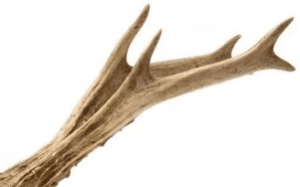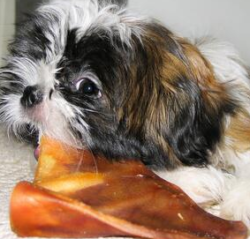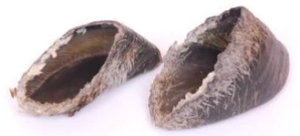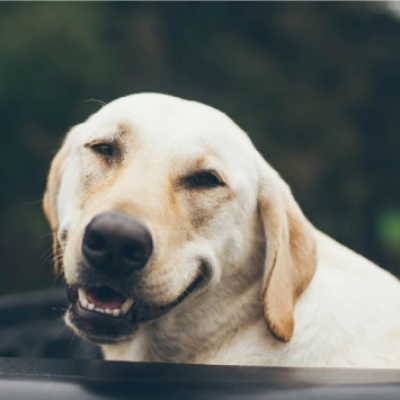I was recently talking with a vet about a scare we had a few years ago with one of our furry family members when he managed to eat a stick and get a wood splinter stuck in his throat. This then involved a trip to the animal hospital (who were wonderful) and a soft diet for a time afterwards.
With this in mind I was interested to know if this was a common problem and I was amazed by the stories I was told. I decided to do some research and found an excellent article which is in part printed below. Details of the full article are listed at the end and our heartfelt thanks to Jason Nicholas, BVetMed (“Dr. J”) for reasearching and writing such an excellent article.
Chews and Chew Toys You Should Not Give Your Dog by Jason Nicholas, BVetMed (“Dr. J”)
Again, I’ll acknowledge that not every dog will have a problem with these toys. However, the likelihood of moderate-to-severe issues is much higher if a dog is allowed to chew on the following (sadly popular) objects and products.
Bones
Now here’s a rather controversial topic… but let’s go there! Spend enough time online and you’ll find plenty of blogs and sites that say it’s OK to give bones to your dog, so long as they’re uncooked and of a specific type. (Thankfully pretty much everyone agrees that cooked chicken, turkey, rib, and other “brittle” bones aren’t safe as they easily splinter and cause digestive upset or puncture).
On one hand, some people will wholeheartedly recommend bones, claiming that uncooked, solid bones (like beef knuckle bones, etc.) can provide hours of safe and natural chewing. They often cite the “naturalness” of dogs chewing on bones, since wolves and dogs in the wild will eat or chew through bones. That’s partially true, but only if you ignore these other facts about bones:
- Bones Splinter: Whether cooked, uncooked, solid, or hollow, bones can and do splinter, yet they’re still hard enough to break teeth. Those splinters can lead to mouth and/or digestive irritation or puncture. You don’t hear about this with wolves and wild dogs because… well… they’re in the wild. But this does happen and those wild dogs will suffer from pain and infection before they die from an inability to eat, peritonitis or sepsissecondary to leakage of stomach/intestinal contents into their abdominal cavity, or other debilitating complications of their bone-related injuries.
- Dogs Don’t Need Bones: Wolves and wild dogs eat bones, in part, to help balance the levels of calcium and other minerals in their diet. Domesticated dogs don’t have such a need for supplemental nutrients, as long as they’re fed a complete and balanced diet (most of the commercially available dog foods are balanced, just look for one with an AAFCO statement).
Even the FDA has issued a warning to pet owners about bones. So yes, because I have seen the damage and devastation that chewing bones can cause, I will go on record and say that bones are best avoided as chews for dogs — regardless of whether the bones are cooked or raw, and regardless of how “natural” some people claim it is for dogs to chew bones.
Hard Cheese Blocks and Bones
Aside from perhaps some lactose-intolerance, cheese shouldn’t pose too much of a problem for dogs, right? Well, when it’s been processed into a rock-hard “block” or “bone” it certainly can. Cheese blocks and cheese bones can be much too hard for regular chewing and can lead to broken teeth for an unfortunate dog. In our own test, the Qchefs Cheese Bone (as shown in the image) did not pass the “thumbnail test” (a good chew should be soft enough that it will give if you press it with your thumbnail). Making matters worse, this particular bone, as well as other hard cheese-style chews, are too small even for a little dog, which could lead to choking or a digestive obstruction, should your dog literally bite off more than they can chew. If you want to give your dog cheese, stick to small amounts of the real stuff (like string cheese), which can make for a great high-value reward/treat during training.
Cow Hooves
Cow hooves used to be all the rage for dog chew toys — fortunately, they seem to have gone out of favor. Of course, you can still find them quite easily. Like bones and other hard chew toys, cow hooves pose the dual dangers of breaking your dog’s teeth or splintering, which could lead to puncture injuries of your dog’s mouth or digestive tract.

Now here’s a SUPER popular dog chew! After all, they’re natural and “sustainably harvested” (elk and deer shed their antlers naturally). But antlers are hard enough to withstand the force of another deer’s antlers in battle, which means they’re definitely hard enough to break your dog’s teeth. They can also be sharp enough to cause oral puncture injuries. In fact, the antler fad has caused enough injuries that many vets and board-certified veterinary dentists have begun issuing warnings to help pets avoid the pain, and for their owners to avoid the costs of antler-related injuries.
Nylabones or Nylon Chew Toys
Like many of the other chews we’ve discussed already, hard plastic and hard nylon chew toys, like Nylabones, can be too hard for your dog’s teeth. These toys have little to no “give,” and as a result they have led to many tooth fractures. If you can’t indent the toy with your fingernail, then it’s too hard for your dog’s teeth. Making matters worse, a reasonably good chewer can rip off pieces of plastic from a Nylabone and swallow them, leading to a likely digestive obstruction. You may have read reports that Nylabones are toxic and can cause seizures; however, there doesn’t appear to be much merit to these claims. The real danger, as I’ve already mentioned, is damage to your dog’s teeth or digestive system.
Pig’s Ears
Pig’s ears are another beast entirely (both literally and figuratively). While pig ears can provide some solid chew time, the coating used on them often leads to digestive upset for your pup and it can stain your carpets. They can also harbor all kinds of nasty bacteria to grow on! And, if those drawbacks aren’t enough, pig’s ears can even become a choking hazard or lead to digestive obstructions if your dog is likely to tear off large chunks and swallow them whole.
Ice Cubes
While not technically a chew “toy,” plenty of people give dogs ice cubes to chew on, especially when it’s hot or their puppy is teething. Unfortunately — like bones, antlers, hard nylon chew toys, and other hard chews — ice cubes can actually be hard enough to break your dog’s teeth. You may not need to dive onto a fallen ice cube before your dog gets to it, but it’s not the best idea to intentionally give ice cubes to your dog to chew.
FYI: You might have heard that ice water causes Bloat in dogs, which is actually a bunch of hot air. Ice water does not cause Bloat in dogs.
Sticks

How to Tell if an Edible Chew or Chew Toy is Safe for Your Dog
The chews and chew toys listed above are some of the most popular things you could give your dog to chew on, but as you can see, they can also be among the most dangerous. And they’re not the only dangerous chews and chew toys for dogs, and there are new things for dogs to chew on coming out each day. It can be hard to stay on top of them all!
Put all of your dog’s chews and chew toys through the “tests” below to figure out whether a particular object is likely to be safe for your dog to chew on:
- Hardness: Apply the thumbnail test: If the toy doesn’t “give” a little bit when you press it with your thumbnail, then it’s likely too hard for your dog and could break their teeth.
- Softness & Durability: The toy also should not be so soft or poorly-constructed that your dog will be able to chew it apart and swallow pieces, chunks, or the stuffing inside.
- Coating: It should not be coated or treated with flavorings that can cause digestive upset or support the growth of bacteria (e.g., the coating on pig’s ears).
- Size & Shape: It should not be so small that your dog could choke on it, nor of a shape that they could get their tongue or muzzle stuck in it. It also shouldn’t be too big for them that they could strain or otherwise injure their jaw working on it. (This can get a bit difficult in homes with multiple dogs of varying sizes, but it’s important to pay attention to the size of the toys that you’re bringing into your home as they relate to the different-sized dogs you may have.)
- Washability: Ideally, you should be able to put it in the dishwasher or washing machine/clothes dryer to be periodically cleaned and disinfected.
- Entertainment Value: It should be able to provide hours of chewing entertainment and distraction, either because it will last a long time, you are able to stuff it with treats/food, or your dog just really enjoys playing with it.
Many thanks to Preventtitve Vet







